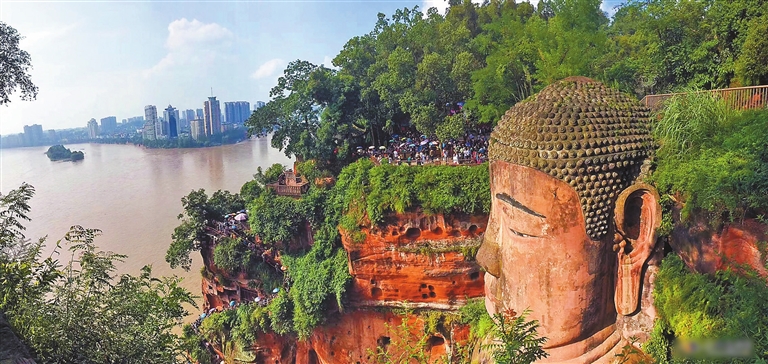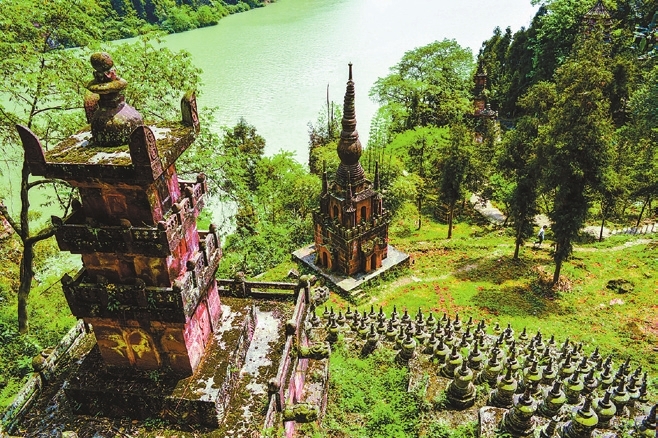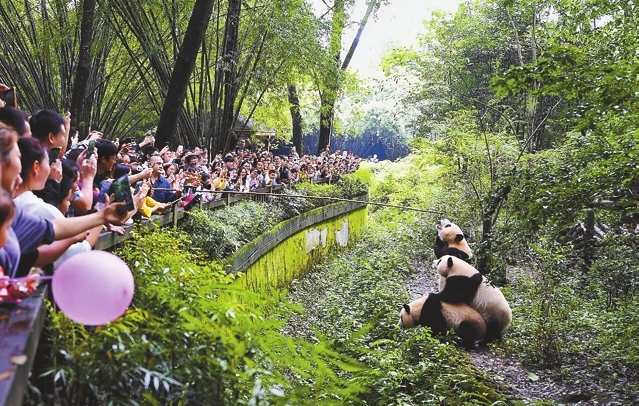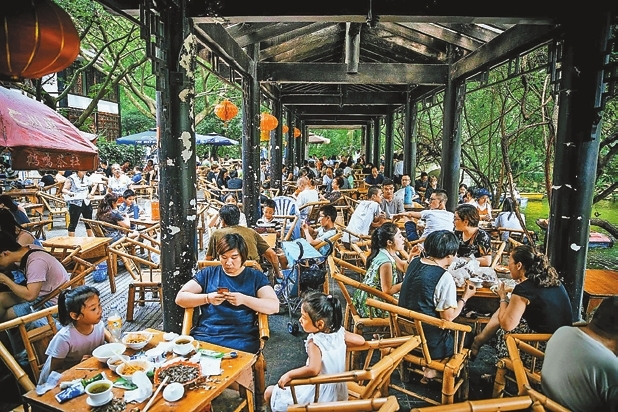





AS cross-province group tourism resumes in China, the 648-km-long Chengdu-Guiyang high-speed rail line that was recently put into service once again becomes popular, as it connects 26 national 5A-level tourist attractions and 386 national 4A-level scenic spots, including Huangguoshu Waterfalls, Baili Azalea, Emei Mountain and Leshan Giant Buddha. It’s the most magnificent high-speed rail in China, which travels from the Sichuan Basin at 240 meters above sea level to the Yunnan-Guizhou Plateau at 2,400 meters above sea level, crossing different terrains including basins, hills, mountains and plateaus. The whole rail line includes 183 tunnels and 468 bridges. It’s the first high-speed rail for tourism in China which connects three provinces: Sichuan, Yunan and Guizhou. It’s also a rail line for foodies, who will be able to treat themselves with dandan mian (Sichuan noodles with peppery sauce), chuanchuan (skewers of vegetables and meat), burning noodles and other delicacies. The 648-kilometer rail line starts in Chengdu, passes through the cities of Meishan, Leshan and Yibin in Sichuan and Zhaotong City in Yunnan Province, before arriving in Guiyang. It has 24 stops and its trains have a designated speed of 250 kilometers an hour. The quickest journey between Guiyang in Guizhou Province and Chengdu in Sichuan Province now takes just two hours and 58 minutes. Chengdu, a city with fun and delicacies Chengdu has gone viral in recent years. With cute pandas, mouth-watering delicacies and the custom of playing mahjong, most visitors are lured to meander around the streets of this leisurely city. One thing that definitely cannot be missed is watching the chubby pandas in the Chengdu Research Base of Giant Panda Breeding. Chengdu is a city brimming with a strong leisurely ambience and one of the highlights lie in its streets and alleys: the renowned historical and cultural street — Kuanzhai Alley, the famous snack street — Jinli Ancient Street, and the pedestrianized shopping street — Chunxi Road. After arriving in Chengdu, do try to experience the tea culture here. Find an old tea house in Renmin Park, Daci Temple or Wenshu Temple, and sit down to savor a bowl of tea while reading the newspaper, or have a lively chat. It’s a great way to enjoy the carefree life in Chengdu. You really have to try the food in Chengdu, one of the four world cities of gastronomy in China. It’s a city that won’t allow you to leave with an empty stomach, from chuanchuan to hotpot, mapo tofu, sliced beef and ox tongue in chili sauce, and dandan mian … you name it. Meishan, hometown of Su Shi and home to “little Cambodia” Sixty kilometers away from Chengdu, Meishan is a poetic place endowed with mountains, flowing water and old towns. It only takes 18 minutes to travel from Chengdu by high-speed train. Sometimes, a city becomes well-known for a single special person. This is exactly the case with Chinese poet Su Dongpo (Su Shi) and his hometown Meishan. As a poet, writer, painter and calligrapher, Su, who lived between 1037 and 1101, is not only a literary giant in Chinese history, but also a world-renowned icon. The Memorial Temple of Three Sus (Sansu Ci) in the southwest section of Meishan is the former residence of the three great poets in the Northern Song Dynasty (960-1127) namely Su Xun, Su Zhe and Su Shi. Their residence was reconstructed as a memorial temple in the Yuan Dynasty (1279-1368) and was worshiped by numerous litterateurs as well as by the masses. After you come to Meishan, don’t forget to check out the “little Cambodia” — Caoyu Shoal. Endowed with poetic scenery, the 18-square-kilometer scenic area is home to a total of 108 pagodas, hence earning the nickname. Liujiang Ancient Town is also worth visiting during your trip to Meishan. Located in Hongya County, Meishan City, Liujiang Ancient Town offers a quiet getaway and an opportunity to experience 800 years of Chinese history. Built in the Southern Song Dynasty (1127-1279), Liujiang was once dominated by some well-off families. There were four well-known clans, namely Zeng, Zhang, Yang, and He. Today Zeng’s Mansion is the most intact residence, resisting the test of time. In addition to the old Chinese-style houses, the old town is also known for its picturesque scenery. Meishan is no doubt a palace for foodies. Dongpo meat, Dongpo fish, double cooked mutton … it’s just a low-key food town that awaits its discovery by foodies. Leshan, a town with real food There is a saying: If you don’t visit Leshan, your trip to Sichuan is wasted. Sichuan is home to many world cultural heritage sites and most of them are located in Leshan: Leshan Giant Buddha, Emei Mountain and Dongfeng Weir, just to name a few. Apart from these renowned heritage sites, Leshan is even more attractive for its local delicacies. There is a saying that people from other places line in Chengdu for local snacks, and Chengdu people line up in Leshan for its delicacies. Cold chuanchuan, deep fried chuanchuan, spicy hotpot, Leshan sweet skin duck, Qiaojiao beef … the saying “Eat in Chengdu, Taste in Leshan” does exist for a good reason. (Chen Xiaochun) | 
